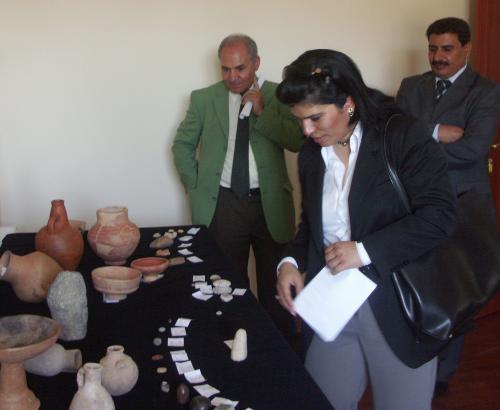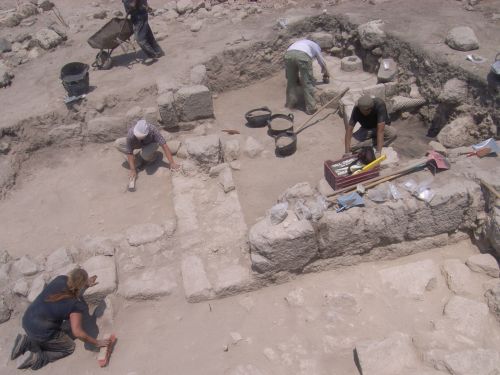2008 - Campaign Summer
The summer 2008 campaign on Tall Zira'a went for four weeks: two for excavation on the tell and two for the processing finds from previous campaigns in the excavation house in Umm Qais. During the latter period an important event took place in Amman: on the 16th July, Prof. Vieweger and Dr. Häser presented 250 objects found on the tell in recent years that had been sent to Germany for restoration to the Jordanian Department of Antiquities. The ceremony was attended by Her Royal Highness Princess Sumaya bint El Hassan, Dr. Fawwaz al-Khraysheh, Director General of the Department of Antiquities, Dr. Faris Nimri, Director of the Jordan National Museum, the new German ambassador, several colleagues from Jordanian and international archaeological institutions along with members of the press. HRH Princess Sumaya's father, His Royal Highness Prince Hassan, is patron of the excavations on Tall Zira'a.
 Her Royal Highness Princess Somaya bint El Hassan and the Director Generalof theDepartment of Antiquities of Jordan, Dr. Fawwaz Al-Khraysheh (right)
Her Royal Highness Princess Somaya bint El Hassan and the Director Generalof theDepartment of Antiquities of Jordan, Dr. Fawwaz Al-Khraysheh (right)
The excavation itself went from the 19th July to the 2nd August and was focussed mainly on the new Area III, where surface finds point to the existence of a large Roman-Byzantine building complex. Participating in the excavation were (apart from the two institute directors) Dr. Ursula Rothe (University of Edinburgh), five staff members from the BAI in Wuppertal, one GPIA Course Programme participant, two students from the Kirchliche Hochschule Wuppertal/Bethel, two students from the University of Edinburgh, a group of architecture students from the Fachhochschule Cologne with their professor, 15 workers from the nearby village of Umm Qais and a number of archaeologists from a variety of German institutions.
In the heat of the summer sun, a great deal was achieved in area III. The oldest stratum reached is a Byzantine building complex consisting of a large courtyard with mosaic floor still partially intact, a large underground cistern (12 x 6 x 5.75 m), the opening for which is in the courtyard, and some of the courtyard's adjacent rooms. This building was repaired and formed the basis for at least two subsequent medieval building complexes and pottery finds point to a particularly intensive use in the Mameluk period. The structures that had been visible on the surface proved to be shallow and to have little connection to the layers below, and as such from another, final building phase, about which, however, little can be said due to the extent of surface disturbance. The quality of the antique and medieval buildings revealed is evident in some of the architectural features: the fine working of the gateway into the Byzantine courtyard, the sophisticated rainwater catchment system in the courtyard with its settling basins and underground piping leading into the cistern and a large, well-preserved grain mill of a later date still found in situ in the easternmost part of the excavation area.
Although a total of 600 m² was opened, the findings show that the complex had a very large ground plan, and the area opened only represents the central part. As a result, the exact chronological sequence of the strata and the function of the various parts of the complex can only be established after further excavation work. The excavation area will need to be extended, perhaps more than double the current size, toward the north, west and east in the following years. The current timeplan for this work is 2009-2011.

Last updated: 2008
|
CURRENT NOTE (2017) The results of the excavation campaigns from 2003 to 2011 are represented in detail in the final publication. |
|
Project Partners |
|
Biblical Archaeological Institute Wuppertal (BAI) |
|
Patronage |
|
His Royal Highness Prince El Hassan bin Talal took up the patronage of this project as a representative of the royal house. |
Friends and Donors |
|
Cooperations |
|
We cooperate closely with many universities, institutes and companies.  |

 print version
print version
